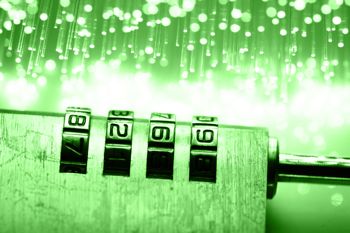A magazine where the digital world meets the real world.
On the web
- Home
- Browse by date
- Browse by topic
- Enter the maze
- Follow our blog
- Follow us on Twitter
- Resources for teachers
- Subscribe
In print
What is cs4fn?
- About us
- Contact us
- Partners
- Privacy and cookies
- Copyright and contributions
- Links to other fun sites
- Complete our questionnaire, give us feedback
Search:
Think of a number

If you add 1 to 1219 you get 1220, except sometimes you get 1210. What’s going on? It all depends on what the numbers mean and what they’re doing. It happens to you all the time and you probably don’t bat an eyelid.
A typical padlock will only open when the four-digit combination is dialed in so that the digits line up correctly. Each disc of digits is separate from the other three and turning one doesn’t affect any of the others. That makes sense - when you choose a combination you are picking 4 completely separate digits.
Clocks go forward
With a typical digital clock on the other hand the digits can be changed separately but they also act as if they are linked. As the time approaches 7am the hour digit won’t change from ‘6’ until the two minute digits have reached 59 (the clock now reads 6:59). At precisely 7 o’clock the two digits on the right will say 00 but the hour digit will also move on from 6 to 7 so that the time reads 7:00. If you were setting an alarm for 7am you might be glad that all three digits act together, and not just the minute ones at the end - otherwise it would be easy to accidentally
With the padlock when you add 1 to a combination 1219 you get the combination 1210. With the clock, adding 1 to the time 12:19 you get 12:20. You need to know what your numbers mean and so how they work if you are to change them correctly.
Can you hack it
There are lots of ways to enter numbers into gadgets, choosing the right one for the job at hand can make a big difference. Perhaps there are ways no one by Gerrit Niezen of Swansea University, the CHI+MED research team played with different ways of entering numbers, and developed a bunch of new ideas to try out. For example, Sarah Wiseman from University College London turned three Sifteo Game Cubes, an interactive toy, into devices for entering numbers. Smaller than a matchbox the cubes have a clickable screen that displays games, or in this case numbers, and they’re sensitive to movement and position, a bit like Wii game controllers. Sarah programmed two of the cubes to display one number each and the third cube to act as an up/down button to change the numbers. She also told the number cubes to behave as separate digits (like the padlock) if the controller was placed above or below them, or as linked numbers (like the alarm clock) if the controller was placed to the left or right of the cubes.
Knowing whether the numbers in your machine act separately or together set your alarm for 6 o’clock instead of 7! has thought of before! At a hack day run can make the difference between an extra hour in bed but it also helps patients to get the right dose of medicine.


